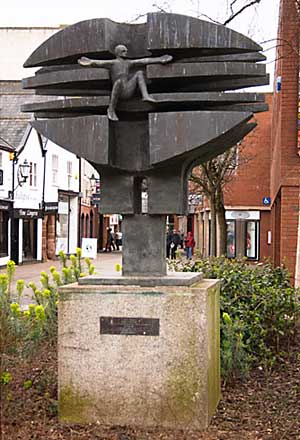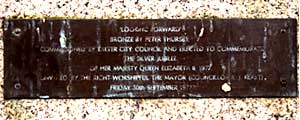
Exeter Stories
Exeter folk and friends in their own words - 1890's to the 1990's | << Previous story | Next story >> |
David Cornforth - retired resident of Exeter
"In 1977, the Queen's Silver Jubilee year, Exeter City Council commissioned local artist, Peter Thursby to produce a bronze sculpture to commemorate the anniversary. Thursby sculpted a life size model of his piece out of solid, expanded polystyrene, and a bronze foundry was found to cast the piece.
I happened to live next to the foundry, in Woodland, near Ashburton. It was basically a hole in the hillside garden of the neighbouring cottage, with a corrugated iron roof to keep out the elements. The foundry was run by Chris Blackmore, who specialised in the Ancient Greek technique of lost wax bronze casting.
Making a start
The polystyrene model was delivered and Chris and his team went about making plaster moulds of the twenty two polystyrene pieces. Each section had a latex mould made which was then filled with wax. When the wax had cooled, the latex mould was peeled off, leaving a solid wax copy of the original part. The wax copy was then covered in plaster which would become the mould for the liquid bronze. To remove the wax from inside the plaster mould, the mould was placed in a paraffin heated kiln where the wax would melt and be burnt out over several hours. Black smoke would drift from the back of the kiln, across my garden.
Weeks went by, and it became apparent that the production of the sculpture would take longer than anticipated, and cost more than the £1000 estimate, made by Thursby. I can remember one and a quarter tons of bronze ingots being delivered at the front gate of Chris' cottage, which alone cost more than the first estimate. Questions were asked in the Council as the cost went to £2000 and then £3000. Meanwhile, after the plaster moulds were produced a start was made on casting each piece in bronze.
A flying visit to the foundry was made by the Mayor of Exeter in a large, black official car. Wearing his chain of office, he sloshed up the muddy path, followed by his advisers, to inspect the work. What he thought of the hole in the ground I'll never know.
Casting in bronze can be dangerous work - one day there were shouts from the hole in the ground and Chris and his workers came flying out - some water in the mould had caused the molten bronze to explode, flinging red hot metal across the work space.
The twenty two pieces had to be carefully assembled, by an expert bronze welder. This took weeks - eventually, when complete, and after the final polishing of the front and back surfaces, the sculpture was ready for delivery.
Moving the 'thing'
An Exeter Council flat bed truck pulled up in the lane on a sunny day in the summer. The problem was, this heavy bronze was in the backgarden and the truck was about 40m away. The sculpture was too big to go down the path, so gaps were made in two hedges so the piece could go across the field - luckily, there were no cows in it at the time. How to carry it - that was the question. A local JCB and driver was summoned, the sculpture hung from the bucket on ropes and it was driven, swinging wildly, across the field to the waiting truck. The Council driver drily remarked that he had been told that he would lose his job if the thing was damaged.
On the 30th September, 1977, the sculpture was unveiled by the Mayor of Exeter. Speeches were made, people congratulated, but no mention was made of Chris and his fellow workers. If you look on the plaque you will see there is no mention there either. I can't remember how long it took to make, maybe 6 months, and at the end the final cost was £5000.
Chris always called it 'the Podman' but the official title is 'Looking Forward'."
 The Looking Forward bronze in the
Guildhall centre
The Looking Forward bronze in the
Guildhall centre
 The plaque
The plaque
 The foundry at Woodland
The foundry at Woodland
│ Top of Page │